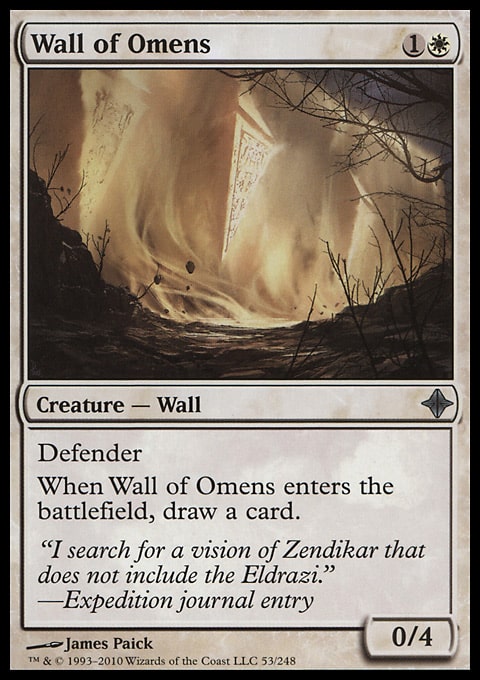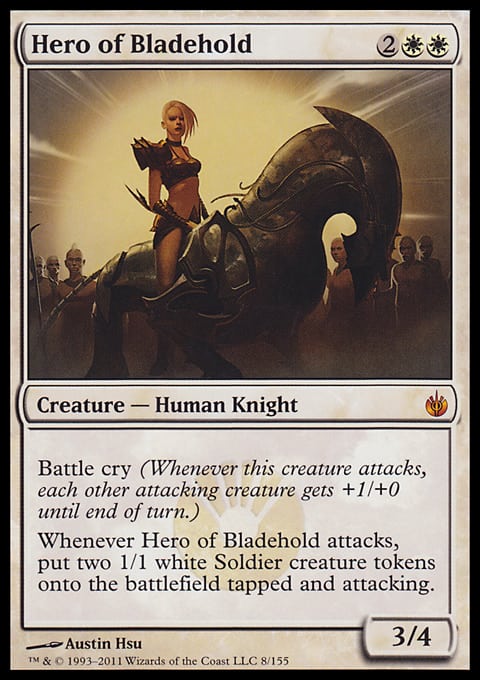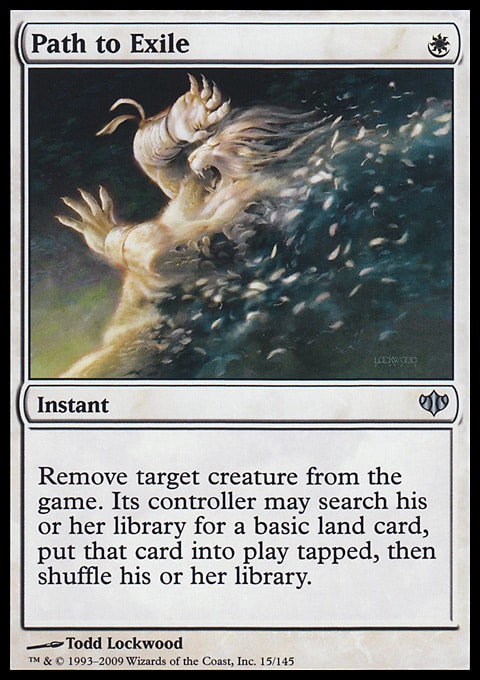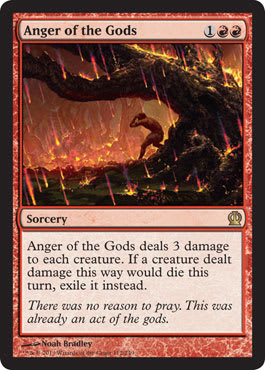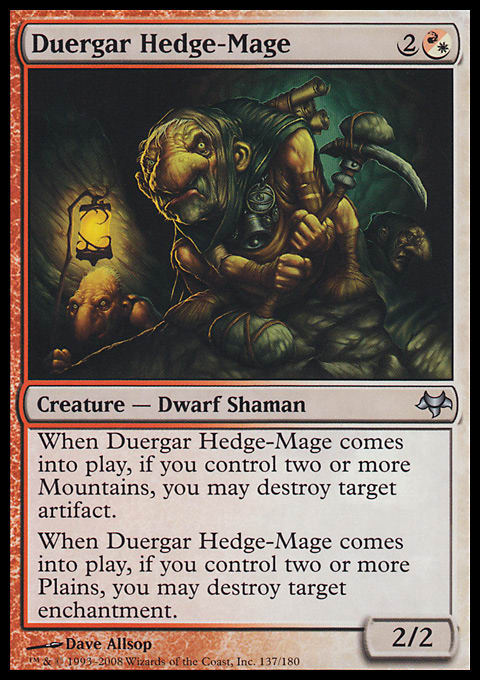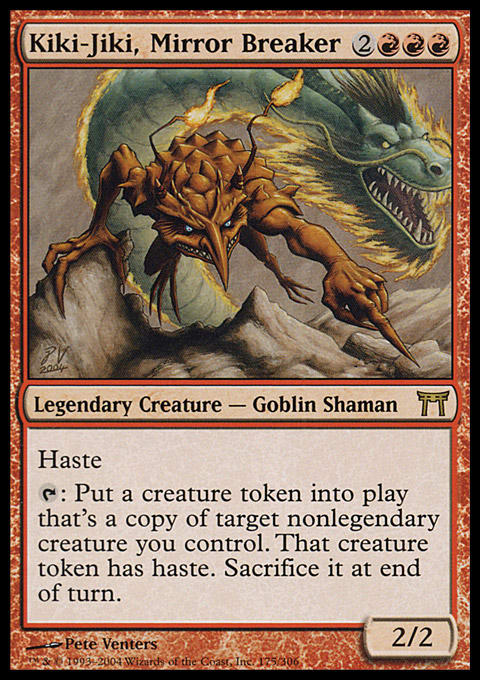Today, I’ll be taking a little step back from my usual budget focus to talk about a sweet Modern deck I’ve been working on over the past week. The deck has a suite of powerful creatures, a strong disruption package, and a surprise combo finish for that oops-I-win moment. It’s also packed to the brim with synergy.
Oops Midrange ? Modern | Mike Cannon
- Creatures (21)
- 3 Hero of Bladehold
- 4 Blade Splicer
- 4 Restoration Angel
- 4 Wall of Omens
- 2 Brimaz, King of Oreskos
- 4 Kiki-Jiki, Mirror Breaker
- Spells (14)
- 4 Lightning Bolt
- 4 Path to Exile
- 2 Flame Slash
- 4 Blood Moon
- Lands (25)
- 2 Mountain
- 7 Plains
- 4 Arid Mesa
- 4 Marsh Flats
- 4 Rugged Prairie
- 4 Sacred Foundry
- Sideboard (15)
- 3 Anger of the Gods
- 3 Duergar Hedge-Mage
- 3 Stony Silence
- 3 Surgical Extraction
- 3 Zealous Conscripts
The Creatures
The creature package starts off with a rather odd choice. Wall of Omens isn’t a card we’ve seen much of since it rotated out of Standard. Here, it gives you something to cast on turn two, helps buy some time against aggro decks, and provides a bit of card advantage.
The card-draw ability is even more relevant due to the presence of Restoration Angel in the deck. Even if your opponent isn’t attacking with creatures, the Wall often ends up providing two cards for 2 mana, which is a pretty good deal in my book. Wall of Omens can also be used to turn Kiki-Jiki, Mirror Breaker into Archivist.
Blade Splicer is an even better target for Restoration Angel, giving you a free 3/3 to go with your flyer. It also makes for one of the greatest combat tricks ever. In testing, I had one game against a Merfolk deck in which I flashed in Restoration Angel to flicker the Splicer, and I then used the token to kill Lord of Atlantis with first strike, making the other creatures smaller before damage. Meanwhile, Restoration Angel took out Kira, Great Glass-Spinner, allowing my removal spells to function again.
Blade Splicer also combines quite nicely with Kiki-Jiki, allowing you to tap it to make a 3/3 with first strike. Once you start making multiples, the first strike starts to be even more powerful. In one game, I used a trio of Golem tokens to fend off an 8/8 creature with lifelink and vigilance thanks to Batterskull.
Brimaz, King of Oreskos doesn’t work particularly well with Restoration Angel, and it doesn’t work at all with Kiki-Jiki, but it is among the best 3-drops available in these colors. The 3/4 body allows it to kill Kitchen Finks and tangle with Tarmogoyf, and it also survives your Anger of the Gods out of the sideboard. The extra token it provides when attacking or blocking is a nice bonus, pushing in some extra damage if your opponent doesn’t have a blocker and allowing Brimaz to effectively be a 4/4 on defense.
Hero of Bladehold is one of my favorite cards in Magic. I put it in the sideboard of my Tempered Steel deck as anti-control tech to recover instantly after a Day of Judgment, and it was an all-star in W/B tokens both in Standard and Modern. It’s a powerful threat that demands a removal spell, and some decks in Modern right now just aren’t equipped to deal with that. Birthing Pod in particular has trouble with Hero of Bladehold since the deck largely relies on Abrupt Decay for removal and has few 4-power creatures. I’m not sure I’ve ever lost a game against Pod after attacking with a Hero, regardless of what deck I was playing it in.
Hero of Bladehold also forms an instant-win combo of sorts with Kiki-Jiki, Mirror Breaker. Making a copy of the Hero and attacking with both makes for exactly 20 damage even with no other creatures on the battlefield. Things can become far crazier than that, however. In one testing match, I used Kiki-Jiki to copy Hero of Bladehold at the end of my opponent’s turn, made a second copy on mine, and then cast another Kiki-Jiki to make a third copy of the Hero. With the other creatures I had on the battlefield, I attacked for over 100 damage.
I’ve already talked a lot about Restoration Angel and Kiki-Jiki, but they really are the heart and soul of this deck. They provide tremendous value on their own, allowing your creatures to dodge removal spells or making hasty copies of whatever you draw. However, it’s when they combine that you get to say, “Oops, I win.” Although trying to pull off the combo without any counterspells may seem impossible to those familiar with more traditional combo decks, it’s not nearly as difficult as it might seem.
With the powerful aggressive creatures and high removal density in this deck, most of the time, your opponent will be on the defensive long before you combo off. Counterspells and removal have to be aimed at things like Brimaz and Hero of Bladehold to avoid death, and once the coast is clear, you can cast the two combo pieces and make an arbitrarily large number of Restoration Angels. For this reason, you’ll usually want to cast any other creatures you have before Restoration Angel or Kiki-Jiki, even if they would be more powerful that turn. Having that instant-win combo to fall back on is incredibly valuable, so force your opponent to deal with your less potent threats first.
The Spells
The inclusion of Blood Moon in the main deck rather than in the sideboard was suggested by a friend, and I’ve been loving it so far. There are an astonishing number of decks in the format that simply fold to a Blood Moon. Although using fetch lands to grab basics can help, that requires your opponent to be aware that the enchantment is coming. In addition, a three-colored deck often won’t have enough fetch lands to find the basics it needs early in the game. Even then, Modern decks have become greedy with spells that cost 2 or 3 colored mana in three different colors, so at worst, Blood Moon can be a significant inconvenience.
Blood Moon also necessitated a somewhat odd mana base for this deck. You need to be able to consistently put two Plains onto the battlefield and still produce ![]()
![]()
![]() with 5 mana. This is why I’ve included a full set of eight fetch lands. They can search up Sacred Foundry to give you both colors of mana or grab a basic Plains to prepare for Blood Moon. Rugged Prairie is also key to making the mana work. Normally, you wouldn’t be able to cast Kiki-Jiki on 5 mana if you’ve drawn three Plains, but Rugged Prairie allows you to do it anyway, converting the white mana into red.
with 5 mana. This is why I’ve included a full set of eight fetch lands. They can search up Sacred Foundry to give you both colors of mana or grab a basic Plains to prepare for Blood Moon. Rugged Prairie is also key to making the mana work. Normally, you wouldn’t be able to cast Kiki-Jiki on 5 mana if you’ve drawn three Plains, but Rugged Prairie allows you to do it anyway, converting the white mana into red.
Although Path to Exile seems like a terrible idea next to Blood Moon, in my testing, it was rarely a problem. If your opponent is locked down under Blood Moon, he won’t be casting anything big you need to get rid of. If he does cast something big you need to get rid of, he’s probably gotten around the Moon to some extent, and another basic isn’t going to do too much damage.
There really is no parallel to Path to Exile in Modern right now. I experimented with other options, such as Chained to the Rocks, but in the end, the importance of having removal at instant speed against decks like Splinter Twin decks and various versions of Birthing Pod decks made me shy away from that option. Also, getting the Sacred Foundry you’ve enchanted with Chained to the Rocks hit by Tectonic Edge is pretty much the worst thing ever.
Lightning Bolt is ubiquitous among red decks in Modern, and in fact, some decks play red largely to have access to the card. It kills many of the important creatures in the format at instant speed, and it can even be aimed at your opponent’s life total or his Planeswalkers. The card drastically improves this deck’s win rate against Melira Pod, one of the most prevalent strategies in the format at the moment.
I originally had Lightning Helix as the third removal spell, but one card this deck can run into problems with is Tarmogoyf. I wanted to be able to more reliably kill the creature without relying solely on Path to Exile, so Flame Slash made the cut. It also only costs 1 mana, making it easier to continue your proactive game plan and giving you another way to kill a creature like Birds of Paradise on turn one.
The Sideboard
Some of the choices here are fairly obvious. Anger of the Gods is great against any deck that wants to swarm you with small creatures, such as Merfolk, Affinity, or W/B Tokens. Stony Silence stops artifacts from working properly, hurting decks like Affinity, Tron, and Birthing Pod.
Surgical Extraction is a fairly recent change to the deck, and it’s one I’m still not completely sure about. It’s less effective than something like Relic of Progenitus against graveyard strategies that go wide, such as Living End decks. However, it does provide extra value against control decks, against which it can remove the target of a Snapcaster Mage to force one of your spells through.
Melira Pod also suffers against the card. Surgical Extraction can stop a creature from coming back with persist, and its ability to remove all copies of the targeted card from the opponent’s deck can cripple or destroy Pod’s combo plan. It also has a few other random uses. In one game, I cast it on an unimportant card in the graveyard in order to look at my opponent’s hand and see if he would be able to stop me if I went for the combo.
Duergar Hedge-Mage is the deck’s answer to artifacts and enchantments. This is a spot I’ve normally seen occupied by Wear // Tear, but the Hedge-Mage provides some extra advantages in this deck. Since the deck only plays two colors, it can reliably put both two Plains and two Mountains onto the battlefield, making that restriction less of a concern. Duergar Hedge-Mage trades Wear // Tear’s instant speed for a 2/2 body, but in this deck, that means more than just a 2/2. It means you can flicker the Mage with Restoration Angel or make a copy with Kiki-Jiki to gain another use out of it at instant speed. That’s enough incentive for me to include it.
Zealous Conscripts is excellent for stealing Wurmcoil Engines against Tron, but its primary purpose is to give you more ways to combo off with Kiki-Jiki in matchups in which your removal spells aren’t very relevant. Against decks playing few to no creatures, you’ll usually have more cards you want to take out than you have sideboard cards for that matchup, so Zealous Conscripts can take fill up the extra space with something useful. Of course, there’s also the possibility of living the dream and using it to steal an Emrakul, the Aeons Torn that your opponent cheated onto the battlefield.
Wrap-Up
My testing so far has shown that this deck could very well be strong enough to perform even in competitive tournaments. It can do some very powerful things, and it’s very hard to completely shut down without an extreme amount of countermagic and removal. It can sometimes struggle somewhat against faster combo decks, but the large amount of disruption can often be used to buy you enough time to combo off yourself.
The only obviously unfavorable matchup I’ve run into so far is Mono-Green Devotion due to its faster combo that can’t always be disrupted by Blood Moon and removal spells, but that deck isn’t a major player in the format. Burn-based decks can also be a problem depending on how many creatures they include. More is better for you since Goblin Guides and Hellspark Elementals tend to have a hard time fighting through 3/4 and 3/3 first strike creatures.
Overall, the list certainly has potential, and it’s by far the most fun deck I’ve played in a long time. If you like crazy synergy decks as much as I do, give it a try, and make sure to join me next week when I return to building on a budget.













